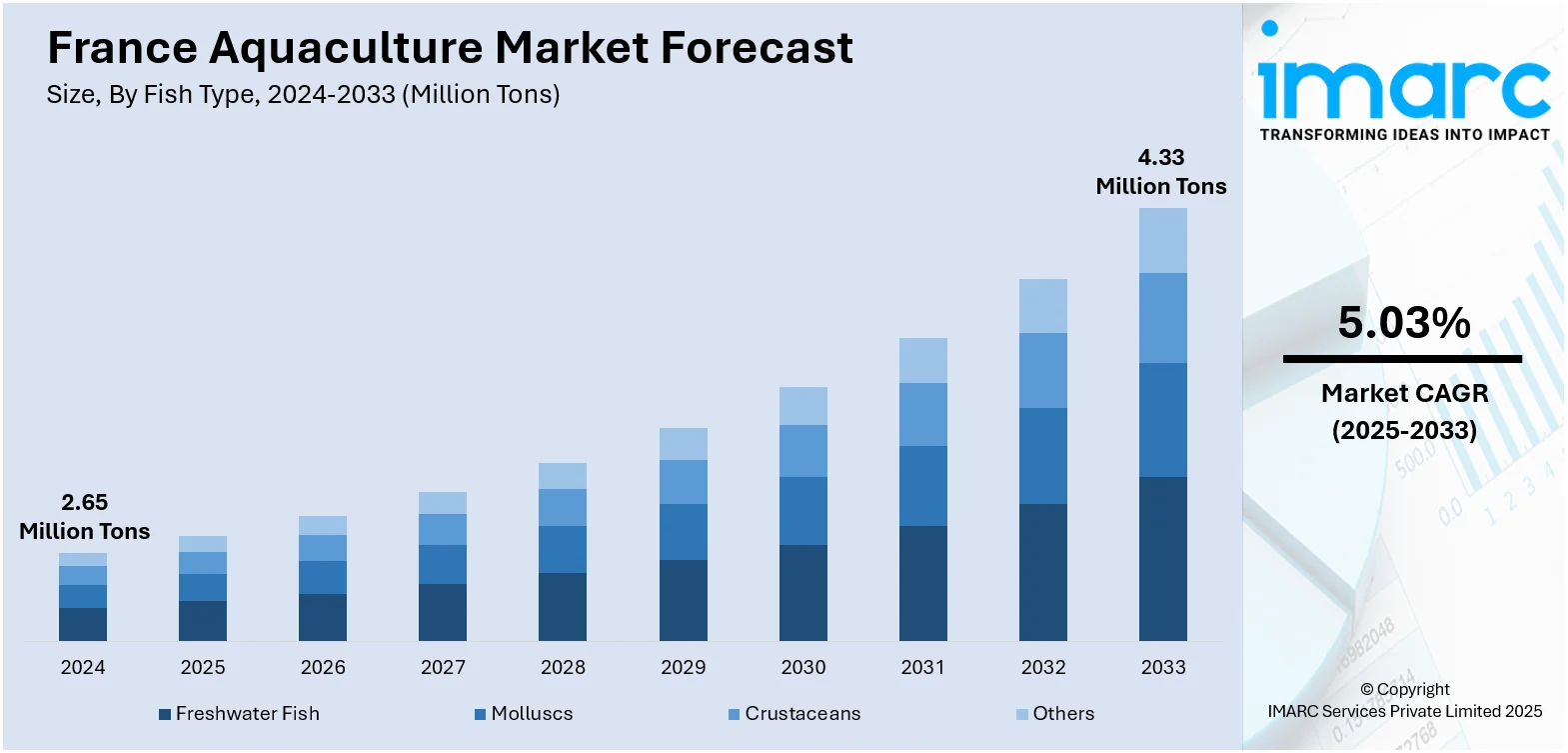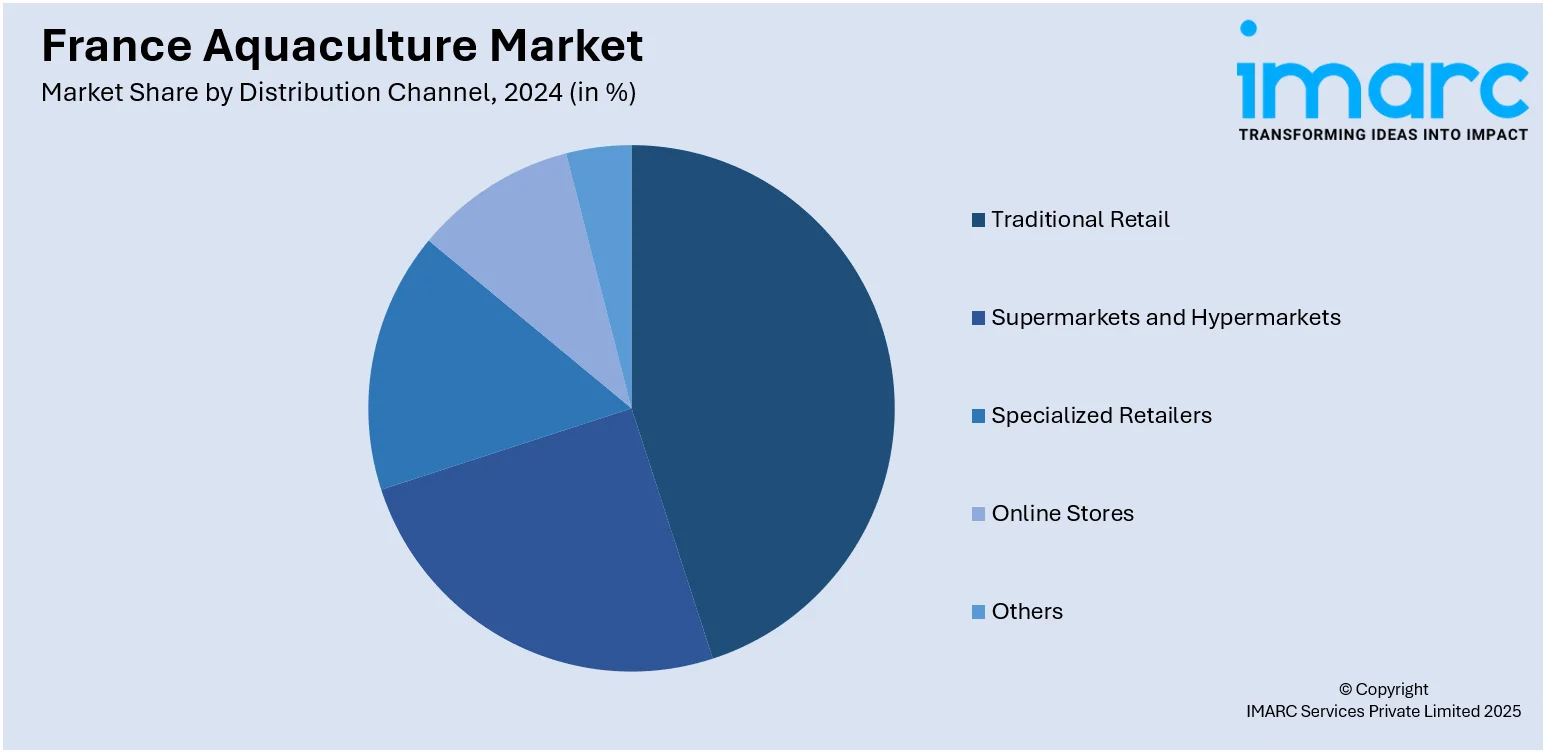
France Aquaculture Market Size, Share, Trends and Forecast by Fish Type, Environment, Distribution Channel, and Region, 2025-2033
France Aquaculture Market Overview:
The France aquaculture market size reached 2.65 Million Tons in 2024. Looking forward, the market is projected to reach 4.33 Million Tons by 2033, exhibiting a growth rate (CAGR) of 5.03% during 2025-2033. The market is driven by rising demand for sustainably sourced seafood, EU-backed sustainability initiatives, advanced farming technologies, and a strong domestic gourmet fish segment. Investments in organic and certified production methods are increasing consumer trust and market competitiveness. These developments are enhancing France aquaculture market share across Europe.
|
Report Attribute
|
Key Statistics
|
|---|---|
|
Base Year
|
2024
|
|
Forecast Years
|
2025-2033
|
|
Historical Years
|
2019-2024
|
| Market Size in 2024 | 2.65 Million Tons |
| Market Forecast in 2033 | 4.33 Million Tons |
| Market Growth Rate 2025-2033 | 5.03% |
France Aquaculture Market Trends:
Sustainable, Energy-Integrated Aquaculture Expansion
France’s aquaculture industry is advancing toward sustainable, energy-efficient production models that prioritize environmental stewardship and animal welfare. Farms are increasingly adopting closed-loop systems featuring advanced biofiltration and renewable energy integration, such as photovoltaic shading, to minimize ecological impact and improve energy self-sufficiency. This approach enables high-volume fish production while reducing resource consumption and pollution. Stronger integration with local processing and supply chains supports regional economic growth and enhances national food sovereignty. These developments reflect a growing commitment within the sector to align with long-term sustainability goals and climate resilience strategies, positioning French aquaculture as a leader in innovative, eco-friendly seafood production. For instance, in July 2025, Maïsadour launched a closed-loop fish farm in Langolen, France, combining cutting-edge multi-stage biofiltration with 6,000 m² of photovoltaic shading for sustainable aquaculture. The farm produces over 600 tonnes of trout annually, improving environmental impact, animal welfare, and energy self-sufficiency. Integrated with local processing and supply chains, it supports regional development and France’s food sovereignty, aligning with Maïsadour’s AMBiTiON 2030 sustainability strategy.

To get more information on this market, Request Sample
Integration of Digital Monitoring
The integration of digital tools and smart monitoring technologies is transforming operational efficiency in French aquaculture. Startups and established firms are developing AI-powered platforms for monitoring water quality, feeding schedules, and fish health in real-time. For instance, BiOceanOr, a French start-up, uses AI with marine biology expertise to optimize water quality and sustainable aquaculture through its AquaREAL service. Supported by the EU’s BlueInvest program, BiOceanOr raised €2.5 Million in funding to expand in salmon farming. AquaREAL provides real-time water quality predictions, helping fish welfare, production efficiency, and environmental management. The company partners with ScaleAQ to enhance digital aquaculture solutions, advancing sustainability and innovation in the blue economy. Such innovations are particularly attractive to trout and shellfish farmers operating in coastal and inland regions. Public funding and collaboration with marine research institutes support these advancements. The rising adoption of digital aquaculture solutions significantly contributes to France aquaculture market growth through enhanced transparency, sustainability, and profitability.
France Aquaculture Market Segmentation:
IMARC Group provides an analysis of the key trends in each segment of the market, along with forecasts at the region/country level for 2025-2033. Our report has categorized the market based on fish type, environment, and distribution channel.
Fish Type Insights:
- Freshwater Fish
- Molluscs
- Crustaceans
- Others
The report has provided a detailed breakup and analysis of the market based on the fish type. This includes freshwater fish, molluscs, crustaceans, and others.
Environment Insights:
- Fresh Water
- Marine Water
- Brackish Water
A detailed breakup and analysis of the market based on the environment have also been provided in the report. This includes fresh water, marine water, and brackish water.
Distribution Channel Insights:

- Traditional Retail
- Supermarkets and Hypermarkets
- Specialized Retailers
- Online Stores
- Others
The report has provided a detailed breakup and analysis of the market based on the distribution channel. This includes traditional retail, supermarkets and hypermarkets, specialized retailers, online stores, and others.
Regional Insights:
- Paris Region
- Auvergne-Rhône-Alpes
- Nouvelle-Aquitaine
- Hauts-de-France
- Occitanie
- Provence Alpes Côte d’Azur
- Grand Est
- Others
The report has also provided a comprehensive analysis of all the major regional markets, which include Paris Region, Auvergne-Rhône-Alpes, Nouvelle-Aquitaine, Hauts-de-France, Occitanie, Provence Alpes Côte d’Azur, Grand Est, and others.
Competitive Landscape:
The market research report has also provided a comprehensive analysis of the competitive landscape. Competitive analysis such as market structure, key player positioning, top winning strategies, competitive dashboard, and company evaluation quadrant has been covered in the report. Also, detailed profiles of all major companies have been provided.
France Aquaculture Market Report Coverage:
| Report Features | Details |
|---|---|
| Base Year of the Analysis | 2024 |
| Historical Period | 2019-2024 |
| Forecast Period | 2025-2033 |
| Units | Million Tons |
| Scope of the Report |
Exploration of Historical Trends and Market Outlook, Industry Catalysts and Challenges, Segment-Wise Historical and Future Market Assessment:
|
| Fish Types Covered | Freshwater Fish, Molluscs, Crustaceans, Others |
| Environments Covered | Fresh Water, Marine Water, Brackish Water |
| Distribution Channels Covered | Traditional Retail, Supermarkets and Hypermarkets, Specialized Retailers, Online Stores, Others |
| Regions Covered | Paris Region, Auvergne-Rhône-Alpes, Nouvelle-Aquitaine, Hauts-de-France, Occitanie, Provence Alpes Côte d’Azur, Grand Est, Others |
| Customization Scope | 10% Free Customization |
| Post-Sale Analyst Support | 10-12 Weeks |
| Delivery Format | PDF and Excel through Email (We can also provide the editable version of the report in PPT/Word format on special request) |
Key Questions Answered in This Report:
- How has the France aquaculture market performed so far and how will it perform in the coming years?
- What is the breakup of the France aquaculture market on the basis of fish type?
- What is the breakup of the France aquaculture market on the basis of environment?
- What is the breakup of the France aquaculture market on the basis of distribution channel?
- What is the breakup of the France aquaculture market on the basis of region?
- What are the various stages in the value chain of the France aquaculture market?
- What are the key driving factors and challenges in the France aquaculture market?
- What is the structure of the France aquaculture market and who are the key players?
- What is the degree of competition in the France aquaculture market?
Key Benefits for Stakeholders:
- IMARC’s industry report offers a comprehensive quantitative analysis of various market segments, historical and current market trends, market forecasts, and dynamics of the France aquaculture market from 2019-2033.
- The research report provides the latest information on the market drivers, challenges, and opportunities in the France aquaculture market.
- Porter's five forces analysis assist stakeholders in assessing the impact of new entrants, competitive rivalry, supplier power, buyer power, and the threat of substitution. It helps stakeholders to analyze the level of competition within the France aquaculture industry and its attractiveness.
- Competitive landscape allows stakeholders to understand their competitive environment and provides an insight into the current positions of key players in the market.
Need more help?
- Speak to our experienced analysts for insights on the current market scenarios.
- Include additional segments and countries to customize the report as per your requirement.
- Gain an unparalleled competitive advantage in your domain by understanding how to utilize the report and positively impacting your operations and revenue.
- For further assistance, please connect with our analysts.
 Request Customization
Request Customization
 Speak to an Analyst
Speak to an Analyst
 Request Brochure
Request Brochure
 Inquire Before Buying
Inquire Before Buying




.webp)




.webp)












